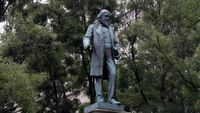For the first time since it was violently toppled and set ablaze by protesters in June 2020, the bronze statue of Confederate General Albert Pike once again stands in Washington, D.C.’s Judiciary Square. Its reinstallation, completed over the last weekend of October 2025, marks a dramatic and controversial chapter in the nation’s long-running debate over how the United States chooses to remember—and sometimes revere—its complicated past.
The statue’s return comes after five years in storage, following its dramatic removal during the Black Lives Matter protests that swept the country in the wake of George Floyd’s murder by a Minneapolis police officer. Demonstrators, wielding ropes and chains, pulled the 11-foot bronze likeness from its 16-foot granite pedestal on Juneteenth, a day commemorating the end of slavery in the United States. Once on the ground, the statue was spray-painted with graffiti and set on fire, a powerful symbol of a nation reckoning with its history of racial injustice and the legacy of the Confederacy. According to Fox News Digital, the National Park Service (NPS) said, “The restoration aligns with federal responsibilities under historic-preservation law and recent executive orders to beautify the nation’s capital and restore pre-existing statues.”
The reinstallation was not a spontaneous act. Instead, it was the result of a concerted push by the Trump administration, which returned to power in 2025 with a renewed commitment to restoring monuments and memorials removed or damaged in recent years. Two executive orders—"Making the District of Columbia Safe and Beautiful" and "Restoring Truth and Sanity to American History"—directed federal agencies to safeguard, restore, and reinstall historic monuments, particularly those targeted during the unrest of 2020. The NPS announced its intention to restore the Pike statue in August 2025, citing both federal historic preservation law and the new executive orders as guiding mandates.
“Unlike the Left, we don’t believe in erasing American history – we honor it,” Defense Secretary Pete Hegseth wrote on X, formerly Twitter, after announcing the return of another Confederate statue in Arlington National Cemetery. The Trump administration’s policy has been clear: monuments, even those honoring controversial figures, are to be preserved as part of the nation’s historical fabric. The administration’s efforts extend beyond Pike, including the forthcoming $10 million refurbishment and 2027 return of the “Reconciliation Monument” in Arlington, which honors Confederate soldiers.
The Albert Pike statue, originally erected in 1901 by the Scottish Rite of Freemasonry, is unique. It is the only outdoor monument to a Confederate general in the District of Columbia and depicts Pike not in military uniform, but in civilian clothes, with Masonic regalia. His right arm is extended, and his left hand holds a book believed to be his influential work, "Morals and Dogma of the Ancient and Accepted Scottish Rite of Freemasonry." The statue’s stated purpose, according to the NPS, is to honor Pike’s leadership and scholarship within Freemasonry. Yet, as The New York Times notes, the statue’s plaque and official statements make no mention of Pike’s service in the Confederate Army or his efforts to prevent Black Americans from gaining the right to vote.
Pike’s legacy is a lightning rod for controversy. He was not only a Confederate general—who resigned in disgrace after being captured and imprisoned by his own troops, and was accused of committing war crimes—but also an associate justice of the Arkansas Supreme Court and a prominent Freemason. Some historians suspect he had ties to the Ku Klux Klan, though this remains debated. What is not in doubt is that Pike took up arms against the United States, and his actions during the Civil War have made his commemoration in the nation’s capital a source of ongoing anger and pain for many.
Local officials in Washington, D.C. have been trying to remove the Pike statue for decades. Representative Eleanor Holmes Norton, the District’s non-voting member of Congress, has been a particularly vocal critic. After the reinstallation, she reiterated her condemnation, stating, “The morally objectionable move is an affront to the mostly Black and Brown residents of the District of Columbia and offensive to members of the military who serve honorably.” She continued, “Pike himself served dishonorably. He took up arms against the United States, misappropriated funds and was ultimately captured and imprisoned by his own troops. He resigned in disgrace after committing a war crime and dishonoring even his own Confederate military service.” Norton has repeatedly introduced legislation to permanently remove the statue and donate it to a museum, arguing that Confederate monuments should be preserved as historical artifacts, not celebrated in public parks.
The controversy surrounding the Pike statue is emblematic of a broader, unresolved national conflict. The protests of 2020, ignited by George Floyd’s death, led to the removal of more than 300 Confederate monuments across the United States. Many Americans saw this as a necessary step toward confronting systemic racism and reimagining public spaces to better reflect the nation’s values. Others, like President Trump and his supporters, viewed the removals as an erasure of history and a dangerous precedent. The executive orders driving the restoration of the Pike statue explicitly frame these efforts as a fight against “revisionist movements” and a defense of American heritage.
The statue’s return has not gone unnoticed by D.C. residents or the broader public. It now stands once again in Judiciary Square, surrounded by fencing and under the watchful eye of security—a stark reminder of its contested status. For some, its presence is a painful affront; for others, a testament to the endurance of American history, warts and all. The debate over its fate is far from over. Norton has pledged to reintroduce her bill to permanently remove the statue and has called for a broader conversation about how the United States chooses to remember its past.
As the nation continues to grapple with the legacies of the Confederacy, racism, and the meanings of public memory, the Albert Pike statue’s journey—from its 1901 dedication, to its fiery toppling in 2020, to its controversial resurrection in 2025—serves as a vivid illustration of the stakes and passions involved. Whether the statue remains in Judiciary Square or is ultimately consigned to a museum, its story is far from finished. For now, the bronze figure of Pike, book in hand, stands watch over a city still wrestling with the ghosts of its own history.





